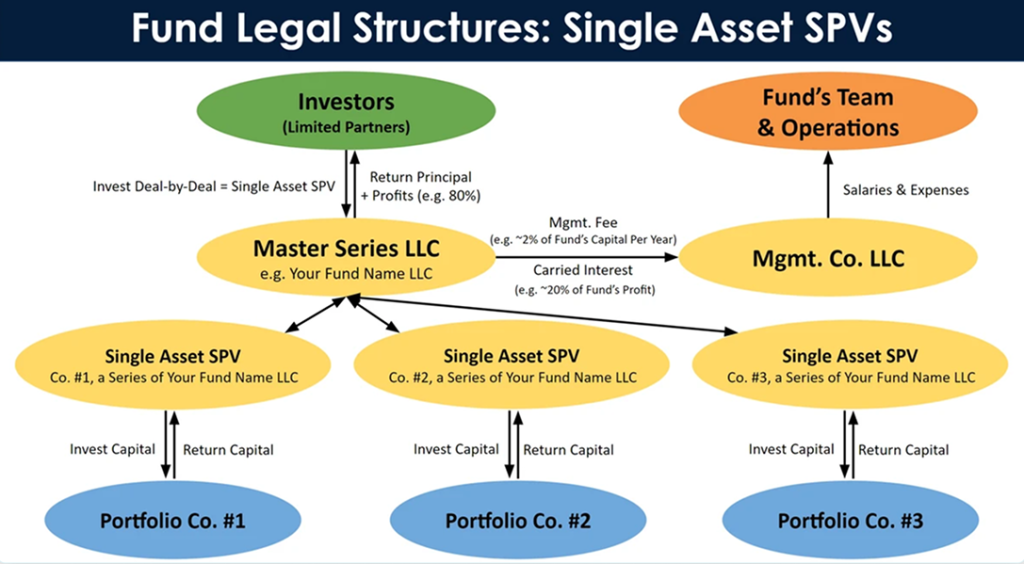These are core terms related to investment vehicles, particularly in private equity, venture capital, and real estate investment.
Here’s a breakdown of each:
1. SPV (Special Purpose Vehicle)
- Definition: An SPV is a legal entity created for a specific, limited purpose. It’s typically used to isolate financial risk or to manage assets in a way that separates them from the parent company’s balance sheet. SPVs are often used in structured finance, mergers and acquisitions, and investments.
- Purpose: The key goal of an SPV is to isolate risk. For example, in real estate investment, an SPV may be created to purchase and manage a specific property, so the liabilities and risks associated with that property do not affect the parent company’s other assets or investments.
- Common Use Cases:
- Real Estate Investment: Creating a separate entity to hold a specific property or set of properties.
- Project Financing: Using an SPV to finance a particular project without involving the parent company’s other assets.
- Risk Isolation: In structured finance, SPVs can be used to isolate risk from the main business operations.
2. Multi-Asset SPV
- Definition: A Multi-Asset SPV is a type of SPV that holds a diverse range of assets rather than just one. These assets could include a mix of real estate, securities, loans, or other types of investments.
- Purpose: The goal is to manage different types of assets under one entity, which could allow.
- Project or Investment Funds: Used by fund managers to structure investments in multiple types of assets for clients.
3. Committed Capital Fund
- Definition: A Committed Capital Fund is an investment fund where investors commit a certain amount of capital to be invested over time. The capital is typically called as needed for investments, and investors cannot withdraw their commitment early unless specific conditions are met.
- Purpose: The capital is “committed” for a specific purpose, such as private equity, venture capital, or real estate investments. The fund manager can then draw down the committed capital when opportunities arise to make investments.
- Common Use Cases:
- Private Equity and Venture Capital Funds: Investors agree to commit capital, which the fund manager can call upon as deals or investment opportunities arise.
- Real Estate Development: A fund might commit capital to a series of real estate developments, and the capital would be deployed as projects begin.
4. Evergreen Fund
- Definition: An Evergreen Fund is an investment fund that does not have a fixed end date and is designed to be self-sustaining over time. Unlike traditional funds with a set lifespan (e.g., 7–10 years), evergreen funds continuously raise capital, make investments, and return capital to investors as it is realized.
- Purpose: The goal of an evergreen fund is to provide long-term growth and liquidity by continually investing, realizing returns, and reinvesting those returns, creating a perpetual cycle of capital generation.
- Common Use Cases:
- Private Equity or Venture Capital: For firms looking to maintain a continuous pool of capital and invest in long-term growth companies without the need to wind down the fund.
- Real Estate Investment: An evergreen fund might continually buy, manage, and sell real estate properties, providing regular returns to investors while keeping the fund active indefinitely.
- Key Feature: The primary difference between an evergreen fund and traditional funds is the lack of a defined exit date, allowing the fund to operate on an ongoing basis.
Summary of Key Differences:
- SPV: A legal entity created for a specific purpose or asset.
- Multi-Asset SPV: An SPV holding a variety of different types of assets, providing diversification.
- Committed Capital Fund: A fund where investors commit capital that is drawn down over time for investments.
- Evergreen Fund: A fund without a fixed termination date, allowing for continuous investment and reinvestment of capital.
Each of these investment vehicles serves a different purpose depending on the investor’s objectives, the risk profile, and the type of assets being managed.
